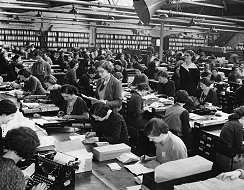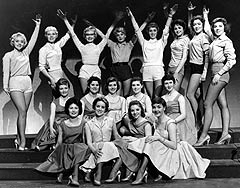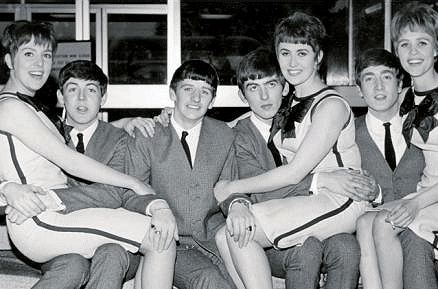Sixties
City presents
a wide-ranging series of
articles on all aspects of the Sixties, penned by the creator of the iconic
60s music paper Mersey
Beat
|
Sixties
City presents
a wide-ranging series of
articles on all aspects of the Sixties, penned by the creator of the iconic
60s music paper Mersey
Beat
|
|||||
|
 |
The
Liverpool football coupons firm Vernons Pools launched The Vernons Girls
as a singing choir in the 1950s, made up of employees, mainly the girls
who checked the pools coupons. Initially they were a 70-strong choir and
made charity appearances and entertained at old folk’s homes, becoming
so popular that Vernons realised the commercial potential for them in
promoting the Vernons name.
Vernons funded the choir, which was slimmed down to 16 girls who became professional, and also decided to hire some ‘outsiders’ - ambitious young girl singers in Liverpool who joined the pools firm specifically hoping to become members of the singing troupe. In 1958 the girls moved to London where they were spotted by television producer Jack Good who signed them up for regular appearances on the BBC show ‘6.5 Special’. When Good moved to ITV to produce the shows ‘Oh Boy’ and ‘Boy Meets Girl’, he also booked The Vernons Girls as regulars on the programmes as the female element seemed popular in shows which featured such up-and-coming names as Cliff Richard, Marty Wilde and Joe Brown. The girls also began to appear on concert bills, made records in their own right and acted as session singers for numerous artists. One of the girls, Eleanor Russell, left the group to join The Fordettes, who travelled the country backing singer Emile Ford. She later moved to London where she formed a quintet to entertain at hotels and clubs. The original sixteen also had a couple of other girls as back-up singers and the Vernons Girls at the time included: Barbara Mitchell, Maggie Stredder, Betty Prescott, Maureen Kennedy, Margot Quantrell, Francis Lee, Jean Owens, Vicki Haseman, Jean Ryder, Vera Brooks, Lynn Cornell, Ann Simmons, Mary Redmond, Ann O’Brien, Joyce Baker, Carmel French, Helen Taylor, Rae Parker, Dilys Jones, Sally Sallies, Gill Graham, Eleanor Russell, Joyce Smith and Sheila Prytherch. |
|
In 1962 due to marriages and ambitions, the girls split into several groups,
although Maureen Kennedy, Francis Lee and Jean Owen continued to perform
as The Vernons Girls. They signed to Decca Records, featuring Maureen, and
reached No.16 in the charts with ‘Lover Please’. They also had minor hits
with ‘Locomotion’, ‘You Know What I Mean’, ‘Funny All Over’ and ‘Do The
Bird.’ It was this trio who featured with The Beatles on the TV show ‘Thank Your Lucky Stars’ on Saturday April 20th 1963. Later that year they also appeared on the first all-Merseyside edition of ‘Thank Your Lucky Stars’ on June 20th. The Vernons Girls: Be My Baby The Vernons Girls were part of The Beatles’ autumn tour of Britain between November 1st and December 23rd 1963 and were included on the ‘Pops Alive!’ show at the Prince of Wales Theatre in London when The Beatles topped the bill on Sunday May 31st 1964. The trio was also booked to appear on The Beatles' Associated Rediffusion Television show ‘Around The Beatles, first transmitted on Wednesday May 6th 1964. Maggie Stredder, Marian Davies and Gloria George became a trio called The Ladybirds and appeared regularly on television on ‘Top Of The Pops’ and ‘The Benny Hill Show.’ At one time Penny Lister became a member. Joyce Baker left to marry Marty Wilde and joined her husband and Justin Hayward in the trio, The Wilde Three. Joyce was to give birth to Ricky and Kim and her daughter Kim was to become a chart artist in the 1980s. Mary Redmond and Ann O’Brien became The Redmond Twins. Lynn Cornell and Ann Simmons became The Pearls. The blonde-haired Lynn was a member of The Vernons Girls when they recorded the single ‘We Love the Beatles’, although the novelty record failed to reach the charts. She did have some success as a solo singer with the record ‘Never On Sunday’. |
 |
|
She later joined a group called The Carefrees with another ex-Vernons Girl,
Betty Prescott. The other members were Barbara Kay, Johnny Evans, John Stevens
and Don Riddell. The group recorded ‘We Love You Beatles’, which was issued
in the U.S.A. on London International 10614 and reached No.19 in the Billboard
charts, with a chart life of five weeks, making it the most successful Beatles
novelty single ever recorded. As a solo singer Lynn was booked to appear on the special all-British edition of the U.S. TV series ‘Shindig’ on which The Beatles appeared. Lynn had lived quite close to Paul McCartney in Liverpool and during rehearsals at the Granville Theatre, Fulham, she was able to talk over old times with Paul. She was also married to Andy White, the drummer on the recording sessions for The Beatles’ ‘Love Me Do’ and ‘P.S. I Love You.’ Maggie Stredder and Jean Ryder became The DeLaine Sisters. Betty Prescott, Margot Quantrell and Vicki Haseman became The Breakaways, who signed to Pye Records in 1962 and issued the single ‘He’s A Rebel’. Margot Quantrell married Tony Newman, drummer with Sounds Incorporated. After 12 months Betty left to appear in a summer season and Vicki left due to some personal problems. Margot was left to perform on her own until Vicki returned and they were then joined by Jean Ryder and recorded ‘That Boy Of Mine’ in 1963. The Breakaways appeared with The Beatles on The Little Richard Show at the Empire Theatre, Liverpool on Sunday October 28th 1962. They also backed various artists on numerous hits including, in 1964 alone: Lulu on ‘Shout’, Cilla Black on ‘Anyone Who Had a Heart’ and ‘You’re My World’, Dusty Springfield on ‘Stay Awhile’ and Petula Clark on ‘Downtown’. Vicki, real name Victoria Mary Haseman, was the eldest of three children and was born in Liverpool on August 23rd 1940. As a teenager she was a member of The Liverpool Philharmonic Choir. She was to marry Joe Brown in 1963 and the couple had a daughter, Samantha, born October 7th 1964, who was to become a hit singer in her own right as Sam Brown. They also had a son, Peter, who is now a record producer. The Breakaways became resident singers on ‘Ready, Steady, Go!’ Jean left for a short period and another former Vernons Girl, Anne Simmons, deputised for her. They continued to record and appear as session singers and also backed Clodagh Rodgers performing ‘Jack In The Box’ in the 1971 Eurovision Song Contest. The group eventually split up in the 1970s and continued with solo careers. Sadly, Vicki contracted cancer and died in Henley on Thames on June 16th 1991. |
 |
|
Article
Text
UK
web hosting by
|